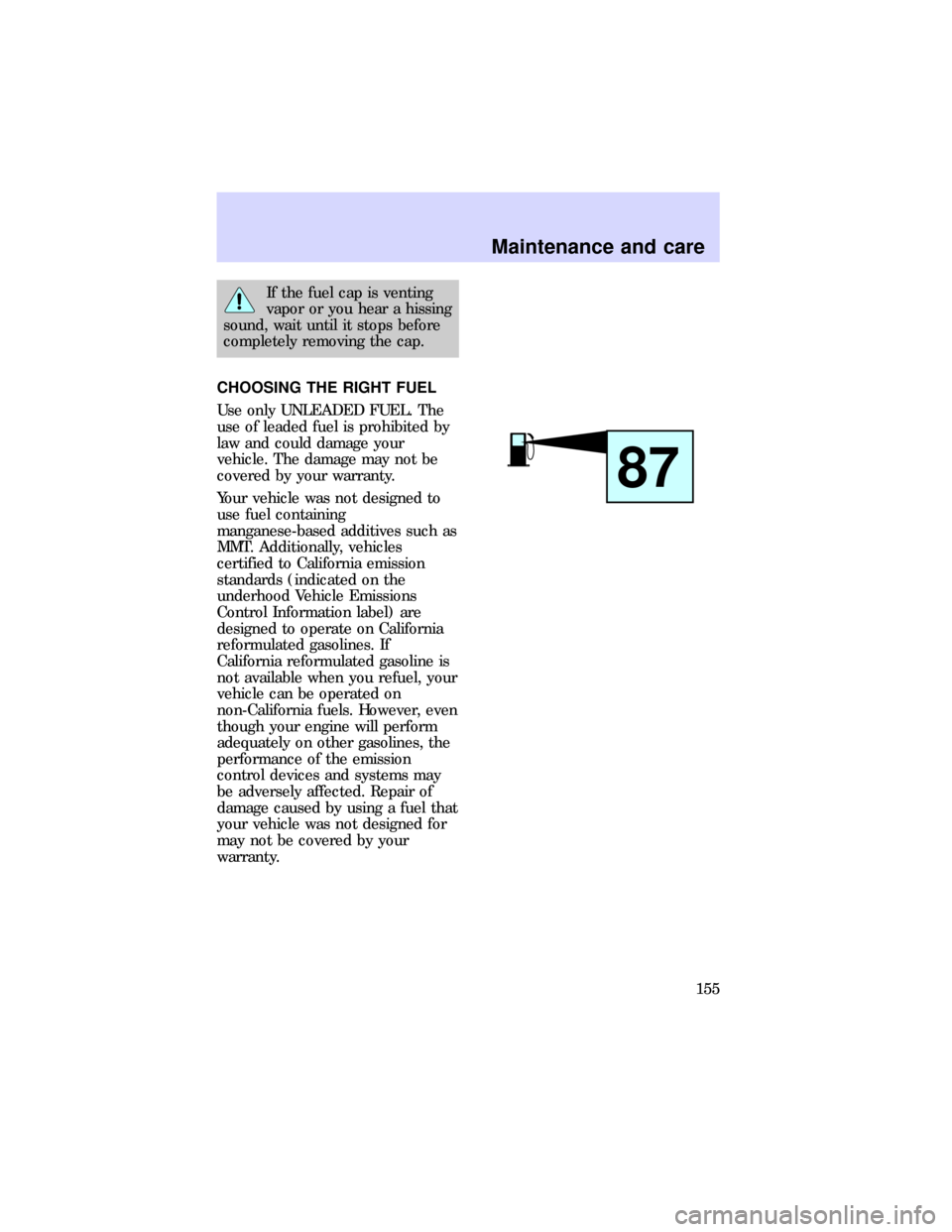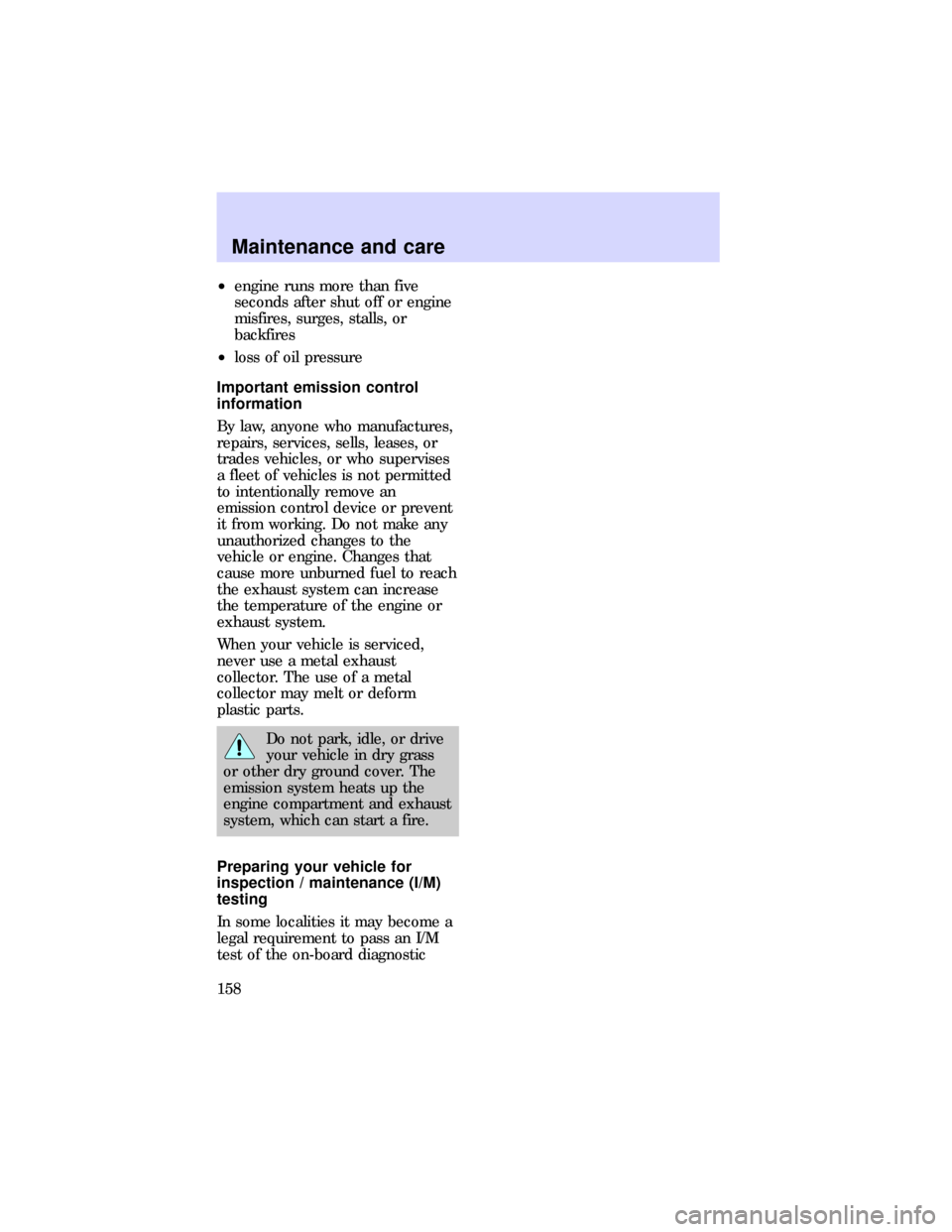Page 155 of 191

If the fuel cap is venting
vapor or you hear a hissing
sound, wait until it stops before
completely removing the cap.
CHOOSING THE RIGHT FUEL
Use only UNLEADED FUEL. The
use of leaded fuel is prohibited by
law and could damage your
vehicle. The damage may not be
covered by your warranty.
Your vehicle was not designed to
use fuel containing
manganese-based additives such as
MMT. Additionally, vehicles
certified to California emission
standards (indicated on the
underhood Vehicle Emissions
Control Information label) are
designed to operate on California
reformulated gasolines. If
California reformulated gasoline is
not available when you refuel, your
vehicle can be operated on
non-California fuels. However, even
though your engine will perform
adequately on other gasolines, the
performance of the emission
control devices and systems may
be adversely affected. Repair of
damage caused by using a fuel that
your vehicle was not designed for
may not be covered by your
warranty.
87
Maintenance and care
155
Page 156 of 191

Octane Recommendation
Your vehicle is designed to use regular gasoline with an (R+M)/2
octane rating of 87. We do not recommend gasolines labeled as
``regular'' in high altitude areas that are sold with octane ratings
of 86 or even less.
Do not be concerned if your
vehicle sometimes knocks lightly.
However, if it knocks heavily under
most driving conditions on the
recommended octane fuel, see
your dealer or a qualified service
technician to prevent any engine
damage.
Fuel Quality
If you are experiencing starting,
rough idle or hesitation problems,
try a different brand of fuel. If the
condition persists, see your dealer
or a qualified service technician.
The American Automobile
Manufacturers Association (AAMA)
issued a gasoline specification to
provide information on high quality
fuels that optimize the
performance of your vehicle. We
recommend the use of gasolines
that meet the AAMA specification
if they are available.
It should not be necessary to add
any aftermarket products to your
fuel tank if you continue to use a
high-quality fuel.
Cleaner Air
Ford approves the use of gasolines
to improve air quality, including
reformulated gasolines, that
contain oxygenates such as a
Maintenance and care
156
Page 157 of 191
maximum of 10% ethanol or 15%
MTBE. There should be no more
than 5% methanol with cosolvents
and additives to protect the fuel
system.
WHAT YOU SHOULD KNOW
ABOUT THE EMISSION
CONTROL SYSTEM
For more information on your
vehicle's emission control system,
see the Vehicle Emission Control
Information Decal located on the
inside left side of the engine
compartment.
The catalytic converter enables the
vehicle's emission control system
to operate properly.
Follow these guidelines to ensure
proper emission system operation:
²Use only unleaded fuel.
²Avoid running out of fuel.
²Do not turn off the ignition
while your vehicle is in motion.
²Have maintenance performed
according to the intervals in the
Service Guide.
If you notice one or more of the
following, the emission system may
not be working properly; have the
vehicle serviced as soon as
possible:
²fluid leaks
²
,,, lights
illuminate in the instrument
cluster and remain lit
²strange odors
Maintenance and care
157
Page 158 of 191

²engine runs more than five
seconds after shut off or engine
misfires, surges, stalls, or
backfires
²loss of oil pressure
Important emission control
information
By law, anyone who manufactures,
repairs, services, sells, leases, or
trades vehicles, or who supervises
a fleet of vehicles is not permitted
to intentionally remove an
emission control device or prevent
it from working. Do not make any
unauthorized changes to the
vehicle or engine. Changes that
cause more unburned fuel to reach
the exhaust system can increase
the temperature of the engine or
exhaust system.
When your vehicle is serviced,
never use a metal exhaust
collector. The use of a metal
collector may melt or deform
plastic parts.
Do not park, idle, or drive
your vehicle in dry grass
or other dry ground cover. The
emission system heats up the
engine compartment and exhaust
system, which can start a fire.
Preparing your vehicle for
inspection / maintenance (I/M)
testing
In some localities it may become a
legal requirement to pass an I/M
test of the on-board diagnostic
Maintenance and care
158
Page 159 of 191
(OBD) II system. If the vehicle's
powertrain system or battery has
just been serviced, the OBD II
system is reset to a not ready for
I/M testing condition. To ready the
OBD II system for I/M testing, the
law specifies that a minimum of 30
minutes of city and highway
driving is necessary as described
below:
²At least twenty minutes driving
in stop-and-go, city-type traffic
with at least four idle periods.
²At least ten minutes of driving
on an expressway or highway.
Before completing the above
driving modes, the engine must be
warmed up and at operating
temperature. Once started, the
vehicle must not be turned off
during these modes.
Maintenance and care
159
Page 171 of 191

The interior overhead lamp is
equipped with a battery saver
control system designed to prevent
excessive wear on the battery.
When a door is not closed
properly, the battery saver control
system timer is activated. The
timer will give you between eight
and ten minutes to close the door
before it automatically turns off
the interior overhead lamp. If the
door is left open, closed, and then
left open again, the timer will
automatically reset.
The battery saver control system is
not activated when the headlamps
are left on. A warning chime will
sound when the engine is turned
off to draw your attention to
headlamps left on.
Map lamp
The map lamps are located in the
rear portion of the interior
overhead lamp assembly.
Replacement of the two bulbs
requires removal of the bulb
assembly cover and the use of
several different tools. See a
qualified service technician or your
dealer for replacement of the map
lamp bulbs.
Hazard flasher
For more information on the
hazard flasher and hazard switch,
refer toUsing the hazard switch
in theRoadside emergencies
chapter. For bulb replacement, see
your dealer or a qualified service
technician.
Maintenance and care
171
Page 177 of 191

Cleaning the instrument panel
Any cleaner or polish that
increases the gloss of the upper
portion of the instrument panel
should be avoided. The dull finish
in this area is to help protect the
driver from windshield reflection.
Cleaning the exterior lamps
Do not use dry paper towels,
chemical solvents, or abrasive
cleaners to clean the lamps; these
products may cause scratches or
crack the lamps.
Cleaning the engine
A clean engine is more efficient
than a dirty one because a buildup
of grease and dirt acts as an
insulator and keeps the engine
warmer than normal. Follow these
guidelines to clean your engine:
²Take care when using a power
washer to clean the engine. The
high pressure fluid could
penetrate sealed parts and
cause damage.
²In order to avoid cracking the
engine block or fuel injection
pump, do not spray these
components with cold water.
²The alternator and air intake
must be covered to prevent
water damage when cleaning the
engine.
²Never wash or rinse the engine
while it is running; water in a
running engine may cause
internal damage.
Maintenance and care
177
Page 179 of 191
MOTORCRAFT PART NUMBERS
Component Ford part number Ð 2.0 liter
SPI engine
Air filter F7CX-9601-AA
Battery BX-58C
Fuel filter FG-862
Oil filter FL400-A
PCV valve EV-229
Spark plug* AGSF-34-E
* Refer to the Vehicle Emission
Control Information (VECI) decal,
located on the underside of the
hood, for gap specifications.
REFILL CAPACITIES
Your vehicle's fuel capacity
The fuel capacity for your vehicle
is 48.0 L (12.7 gallons).
²To avoid overspill from the filler
neck, stop fueling at the second
automatic shut off.
²For more information on fueling
your vehicle, refer toChoosing
the right fuelin the
Maintenance and carechapter.
Capacities and specifications
179